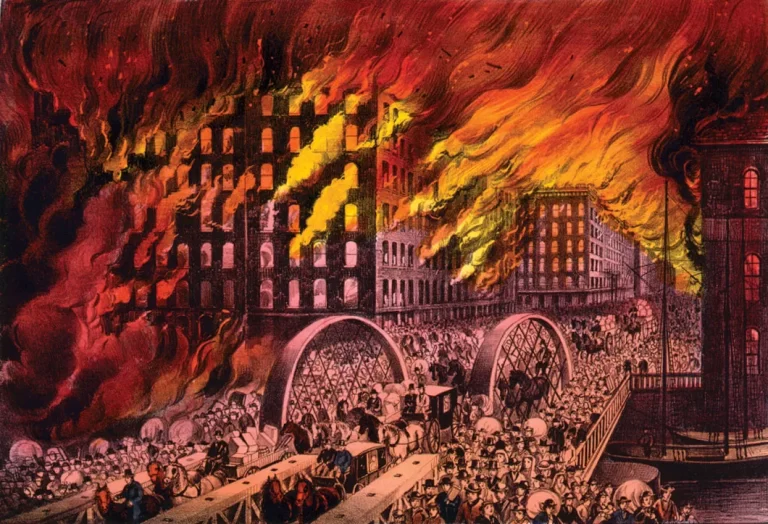Ladies and gentlemen, welcome to a wild ride through the ashes of history, where flames dance with genius and prosperity rises from the smoldering ruins. Today, we dive into the cataclysmic event that rocked the Windy City and forever shaped its destiny: the Great Chicago Fire. Strap yourselves in as we unveil the fiery birth of Chicago’s architectural marvels, driven by the indomitable spirit of renewal and reinvention.
Inferno Unleashed
In the annals of time, few catastrophes have borne such transformational consequences as the Great Chicago Fire of 1871. Born from a tiny spark, this inferno engulfed the city, devouring everything in its path. But like a phoenix rising from the ashes, Chicago emerged from the ruins with an audacious vigor that would redefine architectural norms.
Burning the Old, Embracing the New
In the aftermath of the fire, Chicago’s architectural landscape became a blank canvas for visionary minds. The fire eradicated outdated structures, clearing the way for a daring reimagining of the city’s skyline. With devastation came liberation, as architects seized the opportunity to shape a new urban paradigm.
The Rise of the Skyscrapers
Amidst the charred rubble, one architectural marvel would come to symbolize the city’s unyielding spirit: the skyscraper. As if inspired by the flames that once consumed them, designers like Louis Sullivan and Daniel Burnham defied gravity with soaring steel-framed structures that kissed the heavens. The fire fueled an urgent desire to reach new heights, both literally and metaphorically.
The Burnham Plan and Urban Renaissance
As the city was rebuilt, the fires of inspiration blazed even brighter. Enter Daniel Burnham, the visionary architect who sought to reshape Chicago’s urban fabric with his audacious “Plan of Chicago.” Burnham’s plan transformed the city into a grand stage, where broad boulevards, lush parks, and iconic landmarks harmonized to create a vibrant, livable metropolis. The fire had inadvertently become the catalyst for a roaring urban renaissance.
Bold Designs and Flourishing Prosperity
With every brick laid, Chicagoans embraced a new aesthetic that celebrated innovation, audacity, and the unquenchable spirit of the city. Architects like Frank Lloyd Wright and Ludwig Mies van der Rohe emerged from the flames, pushing boundaries and defying convention. Their bold designs, from Wright’s Prairie School masterpieces to Mies’ sleek, minimalist structures, became the embodiment of Chicago’s architectural prowess.
From Ashes to Ascendancy
As the sun sets on our journey, we reflect on the colossal impact the Great Chicago Fire had on the city’s architectural landscape. It was a crucible of destruction, yes, but it also proved to be a transformative force, igniting Chicago’s drive for progress, innovation, and unrivaled architectural excellence.
The fire that razed Chicago was not a tragedy; it was the birth pang of a renaissance. It forged a city that dared to dream big, embrace audacity, and celebrate the triumph of human resilience. Today, as we marvel at the shimmering skyscrapers that grace the Chicago skyline, let us remember that they rise from the embers of the past, bearing witness to the indomitable spirit of a city that defied the odds.
So, raise your glasses to the architects, the visionaries, and the phoenix that emerged from the flames—the city that, through fire and fury, became an architectural wonderland. Chicago, forever transformed by its burning crucible, stands as
a testament to the enduring power of human creativity and resilience.
In the wake of the Great Chicago Fire, the city not only rebuilt its physical structures but also redefined its identity. It shed the vestiges of the past and embraced a new era of progress and prosperity. The architectural feats that followed the fire were not mere buildings; they were towering symbols of a city’s unyielding spirit.
From the majestic grandeur of the Chicago Water Tower, which defiantly withstood the flames, to the awe-inspiring beauty of the Wrigley Building, Chicago’s architecture became a reflection of its people’s determination to rise above adversity. Each structure, crafted with meticulous detail and infused with artistic brilliance, added another chapter to the city’s evolving story.
As we navigate the streets of Chicago today, we are enveloped by a mesmerizing tapestry of architectural styles. The ornate Gothic spires of the Tribune Tower stand tall alongside the sleek, modern lines of the John Hancock Center. The legendary Frank Lloyd Wright houses, nestled in suburban neighborhoods, serve as a testament to the city’s enduring artistic legacy.
But the impact of the Great Chicago Fire extended far beyond architecture. It propelled the city into an era of economic prosperity. As the flames subsided, Chicago embraced innovation and reinvention, becoming an industrial powerhouse and a hub of commerce. The fire became a catalyst for progress, as new industries flourished and fortunes were made.
The Chicago Stock Exchange, once reduced to ashes, rose from its own wreckage, bigger and stronger than ever. The city became a crucible of opportunity, attracting ambitious entrepreneurs and visionaries from all corners of the globe. It was a place where dreams could be forged in steel and fortunes could be built on the pillars of ambition and resilience.
And let us not forget the cultural renaissance that emerged from the ashes. The fire served as a transformative force that ignited a vibrant artistic and literary scene. The Chicago Renaissance, with its groundbreaking literature, bold theater productions, and avant-garde art movements, became a testament to the city’s creative spirit. Artists like Carl Sandburg and Gwendolyn Brooks found inspiration in the city’s grit and grandeur, weaving tales that celebrated Chicago’s indomitable soul.
In the end, the Great Chicago Fire was more than a disaster; it was a turning point, a crucible of reinvention and rebirth. It propelled the city into an era of architectural brilliance, economic prosperity, and cultural vibrancy. Chicago, like a phoenix, rose from the ashes and transcended its past, etching a new narrative of resilience and possibility.
So, my fellow adventurers, as you traverse the streets of Chicago, take a moment to appreciate the architectural wonders that grace the skyline. Feel the echoes of the fire’s fury and the transformative energy that imbues the city. And remember, as the flames of the past fade into the horizon, Chicago stands as a testament to the audacity of the human spirit and the enduring power of architecture to shape our world.



